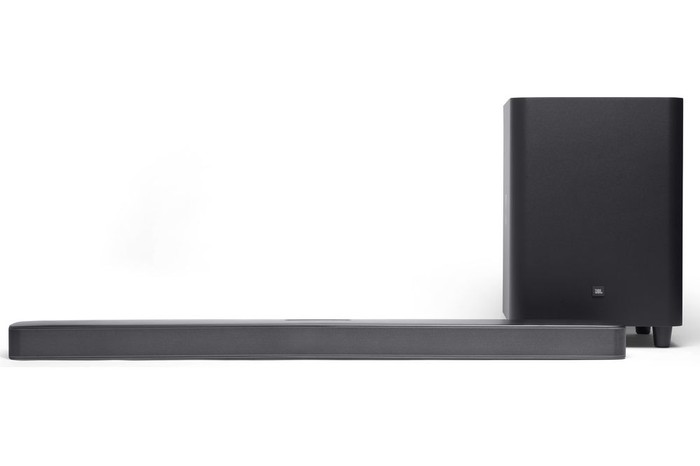The best soundbars for listening to classical music at home
What is a soundbar? How do you choose the right soundbar for your budget? BBC Music Magazine's audio expert Chris Haslam answers all your soundbar questions and recommends 6 suitable for all budgets

The sound from most televisions can be disappointing. The simplest way to rectify this is to buy a soundbar – choose wisely and you’ll enjoy greater detail, depth and realism, while never missing a word of dialogue.
What is a soundbar?
Essentially, a soundbar is a long multi-speaker system that plugs into, and sits beneath, your TV. Having everything contained in one box makes it easier to set up than a full home-cinema system. Many soundbars also come with a separate subwoofer, which hides away behind the sofa, for those rumbling cinema effects.
Most soundbars won’t be as good as a separate surround-sound speaker system, but there are exceptions, with Sennheiser’s flagship Ambeo more than capable of fooling people into thinking they’re surrounded by speakers.
What to look for in a soundbar
Number of speakers
Each soundbar will come with a number that denotes how many speakers it has. A 2.1 system has two speakers and a dedicated subwoofer, while a 5.1 system has five speakers and a subwoofer. Subwoofers can be built-in, too, if you’re worried about clutter – these include the Sony HT-A7000, which has all the bass you’ll ever need. Soundbars with an additional number, like 5.1.2, have two extra speakers that bounce sound off the walls or ceiling for content mixed in Dolby Atmos or DTS:X.
Connectivity
If you want your soundbar to match the width of your TV, check physical dimensions, not screen sizes. Ignore a basic 3.5mm audio jack, and choose a soundbar with at least one digital connector, either optical, coaxial or HDMI. These enable features such as virtual surround sound. Look for a HDMI ARC connection, as this gives your TV remote the ability to control the soundbar’s volume.
Streaming
Most soundbars double up as a streaming speaker using Bluetooth or Wi-Fi, and depending on the brand (Sonos, Yamaha, Bose) can be integrated into a multiroom system. Take time to adjust the sound settings for music, as the mix is typically set for cinema soundtracks and speech.
Dolby Atmos
The next big thing in surround sound allows sound engineers to position and move audio precisely around a viewer, so if you have speakers that can bounce audio off your ceiling, it can feel like things aren’t only happening in front, to the sides and behind you, but above you too.
More like this
Best soundbars to buy in 2023
Denon Home Sound Bar 550

This nine-speaker future-proof design creates an impressive immersive 3D sound, especially given its compact (650 x 75 x 120mm) size and affordable price. Connectivity options are generous, including Wi-Fi for music streaming, and Alexa plus Dolby Atmos too.
Yamaha SR-C20A

Hugely impressive performance at a bargain price, this 100W design has two forward-facing 46mm full-range drivers, an upward-firing 75mm bass driver and two 75mm passive radiators for bass, plus HDMI ARC connectivity and Bluetooth streaming.
Yamaha YSP-5600 £999

It may look like a quick upgrade for your TV’s terrible sound, but this soundbar boasts serious home cinema-sound boasting Dolby Atmos compatibility that just happens to fit inside one box. Hiding 46 speakers, each with a separate amplifier, the soundbar projects acoustics in all directions – 12 bounce sound from the ceiling – helping to recreate an immersive cinema experience at home.
The 128W, 1.2m design is huge and will dominate your living room, especially if you pair it with the £300, Yamaha NS-SW300 subwoofer. Given that all the audio is coming from one position, the engulfing effect is astonishing, even if you’re not playing a Dolby Atmos film like the sublime Roma (Netflix).
Watching BBC Young Musician (BBC Four and iPlayer), the virtuosic playing is elevated by the sheer scale of the soundbar’s output. Rarely has a TV performance felt more alive or cinematic – an experience maintained when streaming music (Wi-Fi, Bluetooth, AirPlay).
Denon DHT-S216

While it lacks Wi-Fi connectivity and voice control, this twin driver design with down-firing built-in subwoofers impressed me with its grown-up looks, detailed performance and wide soundstage. The standout feature is DTS Virtual:X, a 3D mode that tricks your ears into thinking sound is coming from all parts of the room. While 2:1 will never compete with a genuine surround-sound system, the added depth is a welcome boost, especially at this price.
JBL Bar 5.1

With two detachable satellite speakers at each end, this metre-long soundbar is ideal for those who’d love a 5.2 surround sound system but don’t have the space, or maybe permission, to clutter up the living room permanently. With 11 drivers and a hefty 10-inch wireless subwoofer, this 510W system has power but is rarely uncouth. I loved being able to dispatch the wireless speakers for an opera production from the New York Met, for instance, (surround sound mode turns on automatically) and hide them away for a look at the news.
Harman Kardon Citation MultiBeam 1100

With 11 drivers including two up-firing height channels for Dolby Atmos, this is a stylish, do-everything design that can be the heart of your home entertainment. There’s automatic room calibration, Wi-Fi, voice control, audio streaming and a deep, immersive performance.
Authors

Chris Haslam is a freelance consumer technology journalist, specialising in tech, audio, lifestyle, health and interiors. He is the monthly audio columnist for BBC Music Magazine, rounding up the best audio equipment on the market for classical music lovers. He is also a contributing editor for Wired UK.




